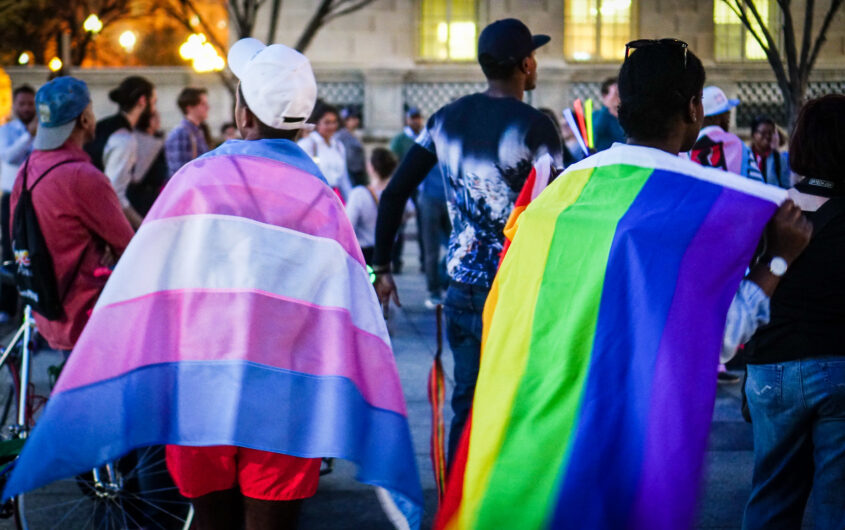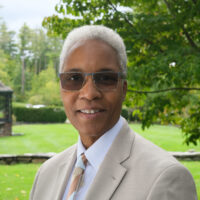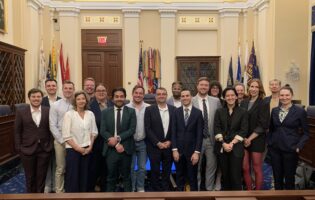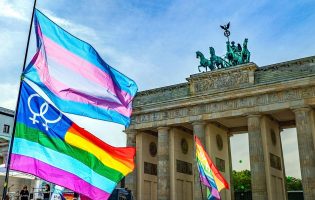
Ted Eytan via Flickr
Divided We Fall

Carla Stephens
Bard College at Simon's Rock
Dr. Carla R. Stephens holds a Bachelor of Arts in Political Science and History as well as a PhD in History from Temple University. Her areas of interest include the transnational nature of the black freedom struggle in the 1950s-1970s, particularly activism by African Americans in the liberation struggles of the former Portuguese colonies in Africa. She also earned her Master of Science in Educational Leadership at Montclair State University. Carla became founding faculty at Bard High School Early College in Newark, NJ, in 2011 and served as principal from 2017 to 2023. She brings leadership training and experience from four years at the United States Naval Academy, National Urban League training, as a manager for AT&T, as well as an educational leader to her current position as Director of the Bard Queer Leadership Project at Bard College at Simon’s Rock.

Carrie-Ann Lawrence
City of Dortmund
Carrie-Ann Lawrence works as a European Affairs Officer in the International Relations Office of the City of Dortmund and as a freelance writer. As a queer woman of color, she has been active in the queer community for many years, both as an activist and in the field of community building. She volunteers to create fear-free workspaces and leisure activities for queer people. With her own series of events, Carrie-Ann has given queer women in particular the space to get to know each other, exchange ideas, and feel a sense of community without having to fear discrimination. She has been honored several times for her commitment, most recently with the “PrOutPerformer in the Public Service” award from the Prout at Work Foundation and the “Recognizing Commitment” award from the Dortmund Volunteer Agency.
Discrimination within the LGBTQIA+ Community
The LGBTQ+ community has always experienced discrimination and persecution. Even if the narrative prevails in some circles that equality has been achieved, discrimination and violence are still a bitter reality for many lesbian, gay, bisexual, trans, and queer people today. In a survey of LGBTQ+ people in Germany on discrimination in various areas of life conducted by Bielefeld University in 2019, 29.7 percent of respondents stated that they had experienced discrimination at work in the last two years due to their sexual orientation or gender (identity). A full 39.9 percent reported discrimination in public or in their leisure time.[1] Violence against the LGBTQ+ community is also steadily rising, with the number of crimes in the area of “sexual orientation” and “gender diversity” increasing almost tenfold in Germany since 2010. The authorities assume that the number of unreported cases is much higher.[2] According to the U.S. FBI, hate crimes against LGBTQ+ people in the United States increased nearly 25 percent in just one year from 2023 to 2024.[3] The fight for acceptance and equal rights is not new and not over.
The modern queer movement gained momentum worldwide largely due to the Stonewall riots in New York in June 1969. The violent police raids on the Stonewall Inn, a bar on Christopher Street, led to several days of protests—a turning point that is now considered the birth of the organized LGBTQ+ movement in the United States. Activists such as Marsha P. Johnson and Sylvia Rivera, two trans women of color, played central roles and exemplify the intersectional character of the early movement. In Germany, queer emancipation took place in a different social and historical context. As early as the Weimar Republic, the Scientific-Humanitarian Committee under Magnus Hirschfeld was one of the first organizations in the world to campaign for the rights of homosexual people. However, this movement was brutally crushed when the National Socialists came to power. Influenced by international developments, it was not until the 1970s that a new wave of queer activism emerged, for example, with the founding of the Homosexual Action West Berlin (HAW).
Another globally influential turning point was the AIDS crisis in the 1980s, which both socially stigmatized the queer community and motivated it to become more politically active. In the United States, movements such as ACT UP emerged to respond to medical neglect and state failure with radical forms of protest. Solidarity within the LGBTQ+ community again proved its importance as lesbians were key supporters of gay men during this tragic time.[4] Similar networks formed in Germany, but with stronger ties to the state healthcare system and less confrontational activism. The crisis promoted international solidarity but also revealed existing racism, sexism, and trans hostility within the queer movement itself.
Despite these past moments of solidarity, forms of discrimination within the LGBTQ+ community are widespread and complex. Discrimination manifests itself in racism, trans hostility, sexism, classism, body shaming, ableism, and the marginalization of nonbinary identities. These exclusions reproduce social power relations even within a movement that is advocating for inclusion.
Many queer spaces—such as bars, dating apps, or Pride events—are often dominated by cisgender, White, gay men. This leads to other members of the community being structurally underrepresented, excluded, or exoticized.[5] This was confirmed by staff from Sub e.V., a cultural center in Munich that, according to its website, is committed to gay, bisexual, and queer men* and trans* people and the entire LGBTIQ+ community. “When women and trans people come to events at Sub, many gay guests don’t like it,” they reported.[6]
In other contexts, too, trans, inter, and nonbinary people regularly talk about being made invisible or even openly rejected in queer cisnormative contexts. Trans women in particular experience a double marginalization: by the heteronormative majority society and by exclusions within queer spaces, for example by trans-exclusionary radical feminists (“TERFs”) or those adhering to binary gender norms. LGBTQ community members report that some TERFs have criticized Munich’s lesbian center for the inclusion of trans people.[7] But it doesn’t stop at criticism. The phrase “Kill all trans” was sprayed on the door of Sub e.V., and the Pride flag hanging next to it was damaged.[8] As trans people are explicitly addressed and only the trans and inter parts of the Pride flag were damaged, it is assumed that this attack was launched from within the community.
Sustainable queer politics must position itself intersectionally, self-critically, and in solidarity.
The answers to the question about the reasons for discrimination within the community are just as diverse as the community itself. While prejudice exists within the queer community, it is also about feeling a sense of belonging. “Without exclusion, there is no belonging,” explains Prof. Dr. Bärbel Schomers, Professor of Social Work at IU International University, and even gives the child a name. “Homonormativity” is the phenomenon of exclusion of all queer identities that are not cis gay men or cis lesbians.[9] Another reason is the fear of losing power and resources. Various LGBTQ+ organizations in Munich report that the state funding landscape historically has favored the division of the scene. There are different funding opportunities for different groups of people. This explains why one rarely finds queer centers that invite all queer people in Munich, but rather small places for specific sexual orientations and/or gender identities.[10]
These inter-community exclusions show: Queer struggles are not automatically intersectional. Critical reflection on one’s own structures is therefore necessary in order to avoid perpetuating the same discriminatory patterns that the movement originally fought against.
It is striking that younger generations in particular understand queer identity as increasingly intersectional, political, and critical of normative structures. So is this a generational issue? The staff of The American LGBTQ+ Museum in New York City and of The Center, the largest queer meeting center in New York City do see differences between the generations.[11] The Center, which was originally set up for gay men, has undergone a paradigm shift in recent years. Not only is Dr. Carla Smith The Center’s first Black lesbian CEO, but the place has also opened up to all people in the queer community. The older, male visitors in particular initially rejected this development. The Center’s administration believes it is important to admit the mistakes of the past and do better in the future. But how can the path to a better and more inclusive future be shaped? A spokesperson from LeTra, an organization in Munich that provides counseling and meeting space for lesbians, has an idea: “We need places where people can meet, get to know each other, and exchange ideas.”[12] Places of encounter that focus not on differences but on similarities.
The queer movement has achieved a lot in recent decades—legally, socially, and culturally. However, power relations that exclude certain queer realities continue to exist within its own structures. A look at the situation in Germany and the United States shows that this is a structural, transnational problem that is deeply embedded in social hierarchies. In a climate in which anti-LGBTQ+ politics grows more caustic,[13] sustainable queer politics must therefore position itself intersectionally, self-critically, and in solidarity—beyond representation and equality for a few.
[1] Lisa de Vries, Mirjam Fischer, David Kasprowski, Martin Kroh, Simon Kühne, David Richter, and Zaza Zindel, “LGBTQI* People on the Labor Market: Highly Educated, Frequently Discriminated Against,” DIW Weekly Report 36 (September 2, 2020).
[2] Federal Ministry of the Interior, “Lagebericht zur kriminalitätsbeogenen Sicherheit von LSBTIQ*,” December 2024).
[3] Delphine Luneau, “New FBI Data: Anti-LGBT Hates Crimes Continue to Spike, Even as Overall Crime Rate Declines,” Human Rights Campaign, September 23, 2024.
[4] Cynthia Laird, “SF was at epicenter of lesbians helping gay men during AIDS crisis,” The Bay Area Reporter, November 16, 2022.
Yale University Online Exhibit, “Lesbian AIDS Activism,” Yale University Library, 2025.
[5] Joel Davis Brown, The Souls of Queer Folk: How Understanding LGBTQ+ Culture Can Transform Your Leadership Practice (Hartford, CT: Publish Your Purpose, 2023), p. 241–61.
See also: Mohamed Amjahid, “Wenn Diskriminierte diskriminieren: Rassismus und Transfeindlichkeit in der queeren Szene – wir müssen reden!” Tagesspiegel, July 25, 2020.
[6] March 25, 2025, meeting with authors.
[7] March 26, 2025, meeting with authors.
See also Julie Compton, “‘Pro-lesbian’ or ‘trans-exclusionary’? Old animosities boil into public view,” NBC News, January 14, 2019.
[8] Tobias Bönte and Joeph Röhmel, Queere Kulturzentren in München: Mordaufruf gegen trans Menschen, Bayerische Rundfunk, August 4, 2024.
[9] Kai Witvrouwen, interview with Dr. Bärbel Schomers, “Diskriminierung innerhalb der queeren Community, SPUTNIK Pride, podcast audio, March 24, 2022.
[10] March 25, 2025, meeting with authors.
[11] On September 19, 2024 the authors visited and discussed these challenges at both The American LGBTQ+ Museum and The Center in New York City.
[12] March 26, 2025, meeting with authors.
[13] Movement Advancement Project Democracy and Equality maps visually highlight the anti-LGBTQ+ landscape in the United States, which, according to Truthout, include over 850 pieces of anti-LGBTQ+ legislation proposed this year (of them, 577 were anti-trans).
This article is part of the project “Building LGBTQ+ Communities in Germany and the United States: Past, Present, and Future” and is generously funded by the Transatlantik-Programm der Bundesrepublik Deutschland aus Mitteln des European Recovery Program (ERP) des Bundesministeriums für Wirtschaft und Klimaschutz(BMWK) (Transatlantic Program of the Federal Republic of Germany with Funds through the European Recovery Program (ERP) of the Federal Ministry for Economics and Climate Action (BMWK)).






